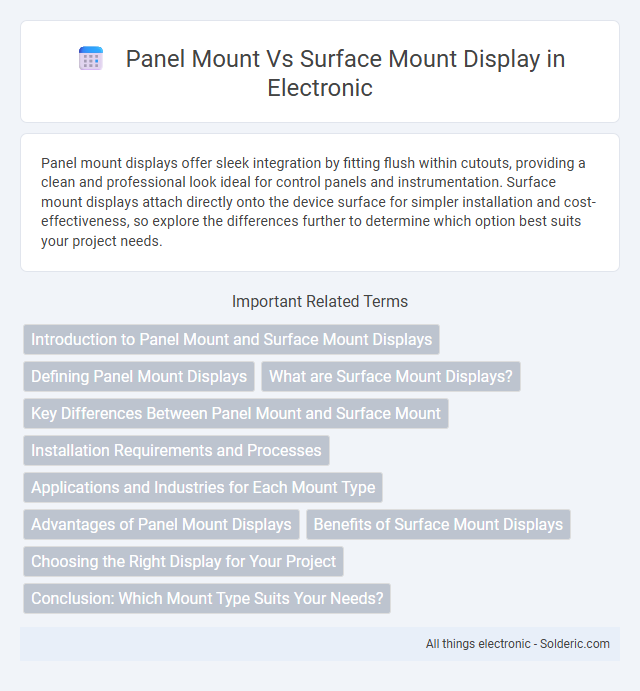Panel mount displays offer sleek integration by fitting flush within cutouts, providing a clean and professional look ideal for control panels and instrumentation. Surface mount displays attach directly onto the device surface for simpler installation and cost-effectiveness, so explore the differences further to determine which option best suits your project needs.
Comparison Table
| Feature | Panel Mount Display | Surface Mount Display |
|---|---|---|
| Installation | Mounted through a panel cutout | Mounted directly on PCB surface |
| Application | Control panels, instruments, equipment front | Compact devices, PCBs with limited space |
| Durability | Higher mechanical protection | Less mechanical protection, sensitive to handling |
| Maintenance | Easier to replace without PCB removal | Replacement may require PCB desoldering |
| Size | Typically larger, designed for visibility | Compact, designed for space-saving |
| Cost | Generally higher due to enclosure and installation complexity | Usually lower, suitable for mass production |
| Signal Integrity | Stable, due to secure mounting | Good, but affected by PCB design constraints |
Introduction to Panel Mount and Surface Mount Displays
Panel mount displays are designed to be installed directly into a panel or enclosure, offering a secure and flush fit ideal for industrial control systems and instrumentation. Surface mount displays, on the other hand, are mounted directly onto a printed circuit board (PCB), providing a compact and space-saving solution perfect for compact electronic devices. Your choice depends on the application requirements, considering factors like ease of installation, durability, and space constraints.
Defining Panel Mount Displays
Panel mount displays are electronic screens designed to be securely installed in a cutout on a control panel or enclosure, providing a flush and integrated appearance for user interfaces. These displays offer robust mounting, easy accessibility, and often include protective bezels to ensure durability in industrial or commercial environments. Your choice of panel mount display ensures a stable setup ideal for applications requiring frequent user interaction and environmental protection.
What are Surface Mount Displays?
Surface mount displays are electronic visual components directly soldered onto the surface of printed circuit boards (PCBs), allowing compact integration and improved electrical performance. These displays, including OLED and LCD types, provide high-resolution visuals and are ideal for space-constrained applications in consumer electronics, industrial equipment, and automotive dashboards. Your choice of surface mount displays enhances device reliability and simplifies manufacturing processes compared to panel mount alternatives.
Key Differences Between Panel Mount and Surface Mount
Panel mount displays are designed to be installed through a cutout in a panel, providing a secure, flush fit with the display face visible on the device's exterior, making them ideal for control panels and instrumentation. Surface mount displays, on the other hand, are soldered directly onto the PCB, allowing for compact designs and ease of automated assembly, which is beneficial in streamlined electronic devices. Key differences include installation method, environmental sealing capabilities, and mechanical robustness, with panel mounts offering superior protection and interface accessibility compared to surface mounts.
Installation Requirements and Processes
Panel mount displays require a front panel cutout where the device is secured with mounting brackets or screws, ensuring a flush and stable installation typically used in control panels or instrument clusters. Surface mount displays are soldered directly onto a printed circuit board (PCB), allowing compact integration with minimal space requirements and streamlined assembly processes ideal for high-density electronics. The installation of panel mount displays is more labor-intensive and involves physical mounting hardware, whereas surface mount displays rely on precise PCB design and automated soldering techniques for efficient mass production.
Applications and Industries for Each Mount Type
Panel mount displays are widely used in industrial automation, medical equipment, and control panels, where secure and flush installation is critical for durability and user interface accessibility. Surface mount displays find strong applications in consumer electronics, handheld devices, and compact instrumentation, benefiting from their ease of integration on printed circuit boards and reduced assembly time. Each mount type caters to distinct industry needs, with panel mounts prioritizing robustness and visibility, while surface mounts emphasize miniaturization and manufacturing efficiency.
Advantages of Panel Mount Displays
Panel mount displays offer superior durability and secure installation by being fixed directly into a device's enclosure, reducing the risk of damage from external impacts. They provide better integration with equipment, ensuring a flush and professional appearance that enhances user interface accessibility. These displays also allow for easier maintenance and replacement without disturbing internal components, promoting efficient device servicing.
Benefits of Surface Mount Displays
Surface mount displays offer compact design benefits, enabling reduced device size and improved aesthetic appeal in electronic products. Their installation on the PCB surface enhances manufacturing efficiency and reliability by eliminating the need for drilled holes, reducing assembly time and cost. These displays also provide better thermal performance and durability, making them ideal for high-density electronic applications.
Choosing the Right Display for Your Project
Selecting between panel mount and surface mount displays depends on the project's installation environment and durability requirements. Panel mount displays offer secure, flush integration with control panels, ideal for industrial settings requiring easy cleaning and protection against dust and moisture. Surface mount displays provide compact, space-saving designs suited for circuit boards and devices where internal assembly and automated manufacturing efficiency are priorities.
Conclusion: Which Mount Type Suits Your Needs?
Panel Mount displays offer robust integration for fixed installations where durability and easy visibility matter, making them ideal for industrial equipment and control panels. Surface Mount displays provide compact, versatile solutions perfect for sleek designs and tight spaces in consumer electronics or portable devices. Your choice depends on whether you prioritize ruggedness and fixed placement (Panel Mount) or flexibility and space-saving design (Surface Mount).
Panel Mount vs Surface Mount Display Infographic

 solderic.com
solderic.com